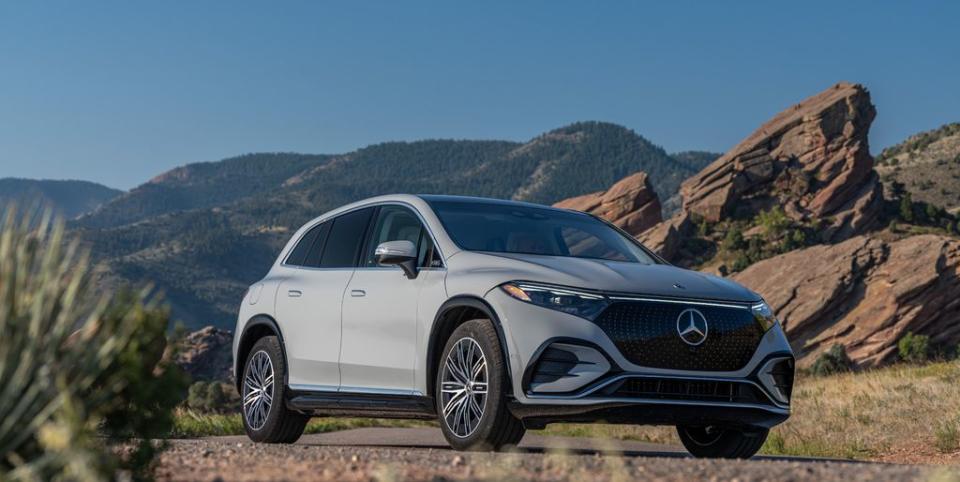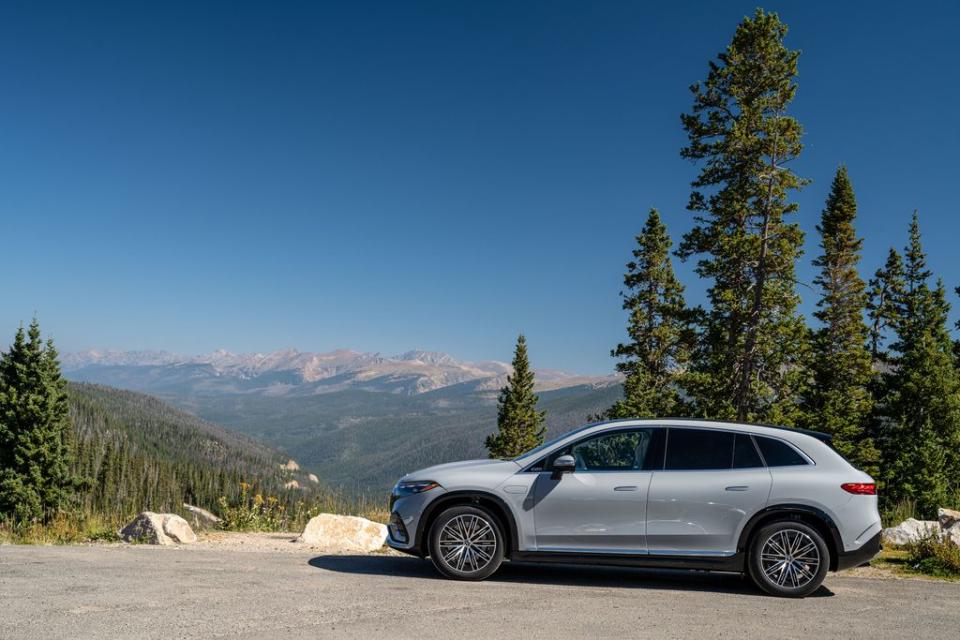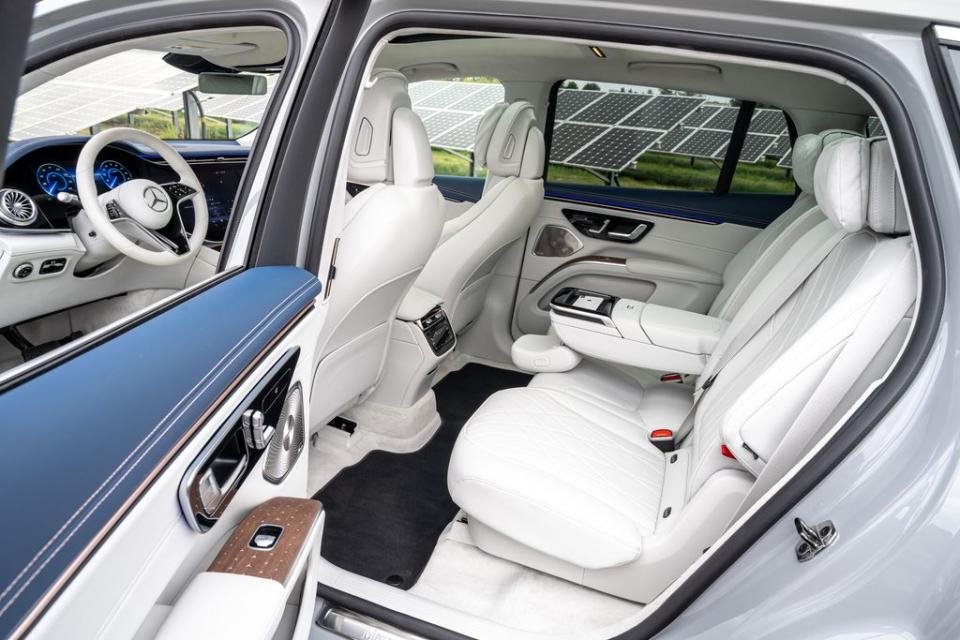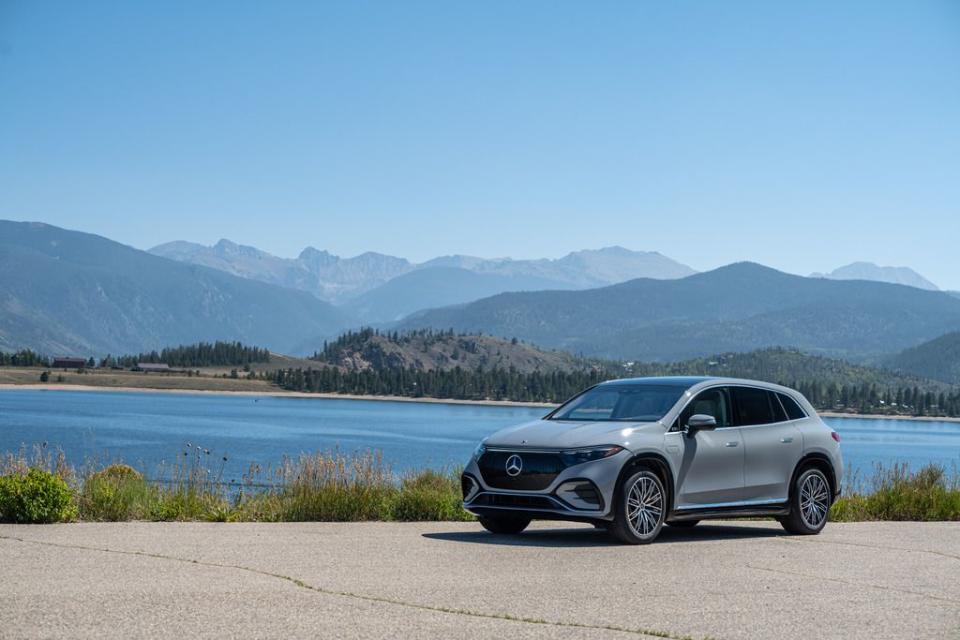The Mercedes EQS SUV Doesn't Feel Revolutionary

We’re off-roading an electric Mercedes SUV, a phrase I’ll bet you never expected to read in a car review. I know I didn’t.
Yet here we are, crawling silently up a rocky Colorado slope in the Mercedes EQS SUV, the ‘Bama-built follow-up to the EQS sedan. And the EQS’ dual offerings illustrate how the old automotive playbook is being wadded up and tossed. Despite its flaws, the EQS sedan already staked a claim to being Mercedes’ tech flagship, torpedoing the fossil-fueled S-Class, hastening its dive toward the ocean floor of obsolescence. (We know that technical leadership is kind of a big deal at Mercedes, and the brand is determined to eventually go fully electric). At the same time, roughly two of every three Mercedes buyers in America write their check for an SUV, not a car. So the EQS sedan’s reign, if that’s what it was, ends up a tad shorter than Queen Elizabeth’s. In sales popularity at least, Mercedes expects the EQS SUV to usurp its sedan sister, as is happening at every luxury brand. And there we have it: An electrified SUV, with an optional third row and a theoretical taste for the outdoors, becomes the new billboard for the Mercedes brand.

In this case, the EQS’ taller-riding throne gives Americans more reason than usual to send the sedan to the guillotine: The EQS sedan’s claustrophobic back seat is a major demerit in a car of its size and demeanor. The Mercedes CLS-Class at least had the excuse of sacrificing practicality for sinuous beauty; the EQS’ sedan’s own sloping, hybrid-esque roof has yet to inspire any critical sonnets.
The EQS SUV solves the back-seat issue. Sharing the sedan’s lengthy 126.4-inch wheelbase, but nearly eight inches taller, the SUV carves out the legitimately roomy, airy second row you expect in a full-size vehicle. Especially in the back, the gain isn’t merely headroom, but what seems at least one-third more side glass area than the sedan. An optional $1,250 third row—surprisingly, with no power folding features—brings seven-passenger possibilities, including just-enough room for adults on shorter trips, albeit with tricky ingress and egress.

America-first layout aside, the EQS SUV is the tech-and-luxury powerhouse you’d expect in an EV that starts at $105,550. Coincidentally or not, that price is smack atop the spectacular, petrol-powered Range Rover at $105,530; Mercedes may hope to lure a few electric converts before the Rover itself gets stuffed with batteries. Mercedes also thumbs the scale for EQS shoppers, pricing the base SUV at just $100 more than the EQS sedan.
Top tech includes a standard air suspension, rear-axle steering, and the optional 56-inch Hyperscreen, the IMAX experience of automobiles. It’s guaranteed to dazzle occupants with bravura displays, augmented reality navigation, and a 12.3-inch OLED passenger touchscreen. Its MBUX interface gets the “Zero Layer” design that plasters key functions on the home screen, and uses AI to add suggestions via “Magic Modules”—a phone number that one reliably calls on the drive home, or the Charge module as you approach a Plug-and-Charge station. Set a course, and the nav system’s “Electric Intelligence” plans the fastest route, including the most convenient charging stops, and adjusts dynamically to traffic jams or changes in driving style. AI also allows predictive range estimates that peer into the past and future, analyzing everything from driver behavior to nav routes, traffic, topography, and ambient temperatures. Within the first 10 miles of one drive, the Mercedes pegged my remaining range on arrival by 1 mile.

That $105,500 price nets a single-motor, rear-drive EQS 450 + with a yawn-inducing 335 hp and 419 lb-ft of torque. A stronger jolt, including a roughly 4.6-second scamper to 60 mph, requires spending at least $127,100 for an EQS 580 4Matic Premium, with 536 hp and a gutsy 633 lb-ft. A top-shelf EQS 580 4Matic Pinnacle starts from $133,350. For any model, 4Matic all-wheel drive adds $3,000.
All models squeeze a 12-module, 108.4 kWh battery below the floor, giving the EQS 450 + an EPA-rated 305-mile range that feels easily achievable in everyday driving. EQS 450 4matic and EQS 580 4Matic versions offer 285 miles of range. The Mercedes can’t quite match the charging speeds of a Lucid Air—or Hyundai-Kia-Genesis EVs, for that matter. But it can slurp current at up to 206 kilowatts (200 kW officially), and sustain a roughly 160 kW average on a fast DC connection, for a claimed 10-to-80 percent recharge in 31 minutes. That includes two years of free fill-ups on the Electrify America network.

The SUV’s exterior is doggedly conventional, with no desire to upset the suburban bourgeoisie. For better or worse, it’s the antithesis of the BMW iX, which envisions the electric future, and doesn’t much care what you think. Visual statements are limited to the Benz’ plastic-encased “Black Panel” grille, with striking LED lighting that includes optional, tiny Mercedes stars orbiting a larger three-pointed honker. But especially in lighter paint colors, all that soft body surfacing put me in mind of melting ice cream; or a Porsche SUV that spent too much couch time during Covid. Driver-assisting cameras and sensors hide behind the starry badge, with more cameras in the front fascia, side mirrors, and behind the windshield. Aero wheels squeeze efficiency from the electric powertrain, with energy-saving tires of 20 or 21 inches.

 Yahoo Autos
Yahoo Autos 